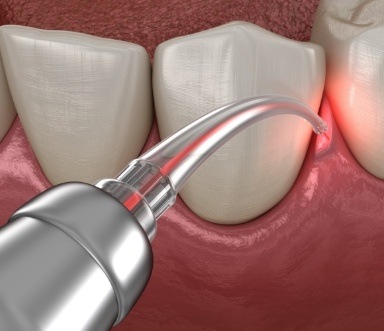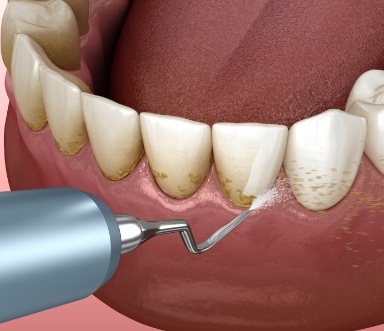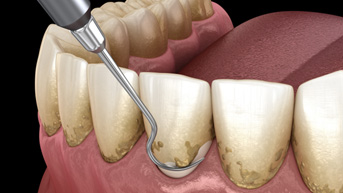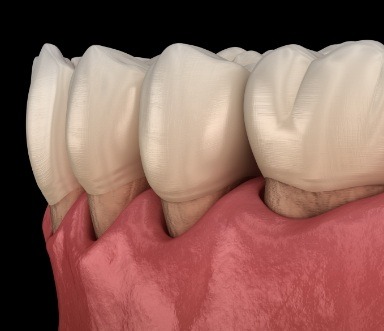Periodontal Disease Treatment – Burlington, MA
Corrective Gum
Disease Treatment

At our Burlington, MA dental office, our professional dental hygienists perform comfortable periodontal therapy (deep cleaning). Your dental health depends on the robust wellbeing of your gums. Patients with untreated gum disease risk destruction of gums, loss of teeth, weakening jawbone, and facial collapse. There is a well-documented relationship between dental health & overall health, including diabetes, heart attacks, stroke, and low birth weight babies.
Have you seen the yellowish film on your teeth? Well, that’s plaque, and it’s formed when oral bacteria consume sugars from food and emit acids. These acids are what cause cavities and gum disease. Keeping an oral hygiene routine is vital to removing plaque and preventing tooth decay and periodontal infections. Visiting our Burlington dentist at least twice a year can also ensure your continued good dental health. We can also provide periodontal therapy in Burlington, MA when necessary after gum disease causes damage.
Why Choose Complete Dental Care for Periodontal Disease Treatment?
- Soft Tissue Lasers for Quick, Painless Treatments
- 30 Years of Providing Comprehensive Care
- Dental Insurance-Friendly Dental Office
Soft Tissue Laser Therapy

Chances are likely you may have gum disease … even if you don’t have any obvious symptoms. More than 80% of Americans have gum disease and need periodontal therapy, but more than half of these patients are undiagnosed. At Complete Dental Care, we stay on the cutting edge of dental technological advances, which is why we incorporate lasers as part of our treatment programs. Lasers are particularly effective at eradicating gum disease. Laser periodontal therapy has several benefits. Patients don’t have bleeding or swelling, won’t need sutures, and rarely experience discomfort during or after their procedure. We typically perform scaling and root planing, gum tissue removal, and gum grafting as necessary with soft tissue lasers.
Treat Gum Pain & Gum Disease with Deep Cleanings

The first step in treating gum disease is typically more frequent professional teeth cleanings performed by our skilled hygienists. Additionally, we may recommend any combination of the following advanced treatment options:
- Scaling and root planing – scaling is the systematic removal of damaged gum tissue, plaque, and tartar. This can be done by using a scalpel and metal scraping tools or with our state-of-the-art soft tissue laser. Root planing is a procedure that smooths the porous root systems of teeth in order to prevent future plaque and tartar buildup and the associated damage to gum tissues. In most cases, these two procedures are completed at the same time, and may or may not be followed with antibiotic therapy.
- Antibiotic treatments – topical antibiotics are beneficial in preventing re-infection of the gums because bacteria are the initial cause of gum disease. The plaque produced as a waste product of bacteria leads to tooth decay and gum disease. If we reduce the number of bacteria in patients’ mouths, the amount of plaque production is limited, which may significantly reduce the risk for ongoing periodontal disease.
- Ongoing at-home and in-office care – following necessary treatments for gum disease and its resulting damage, the patients’ work is not done. We will partner with patients to develop a personalized home care routine that prevents additional gum disease damage. Additionally, we will likely advise these patients to continue more frequent professional teeth cleanings in order to maintain their oral health.
Scaling & Root Planing

If gum disease is caught early, we can help to put you on a path towards recovery with a special type of dental cleaning called “scaling & root planing.” First, we remove all of the bacteria filled tartar accumulated around the gumline, and then the roots are smoothed down. This helps to boost the healing process, making it more difficult for plaque to gather in the future. Read on to learn more about this treatment and find out if it could benefit you!
Do You Need Scaling & Root Planing?

To find out if scaling and root planing is ideal for you, we will first complete an examination of your mouth. X-rays are also captured to collect as much information as we can. Depending on the condition of your gums, the depth of the pockets, and the progression of your gum disease, we might recommend scaling & root planing.
The Process of Scaling & Root Planing

The complete scaling and root planing process is usually completed over the course of two appointments, but this can vary from patient to patient. To remove plaque and tartar, we will start by scaling the teeth with dental tools. We will target the gumline and beneath – where bacteria build up.
After the scaling portion is complete, we will move on to the root planing part of the treatment. This is when we smooth down sections of the teeth beneath the gumline. This helps the gums to adhere to the teeth, speeding up the healing process by making it more difficult for bacteria to build up again. Ultimately, this process reduces the risk of developing gum disease again in the future.
Aftercare Tips for Scaling & Root Planing

It is normal for the gums to feel sore after scaling and root planing. They may also be inflamed. This is temporary and should subside over a couple of weeks. Here are some tips to help the healing process go quickly and smoothly.
- Brush your teeth twice a day with a soft-bristled toothbrush and fluoridated toothpaste.
- Rinse your mouth with saltwater after meals.
- Floss every day.
- Stick to a soft diet following your treatment.
- Avoid foods and beverages that are spicy, acidic, or hot.
- Refrain from intense physical exercise until the area has healed.
Side Effects & Warning Signs of Gum Disease

Advanced gum disease (periodontitis) can cause multiple issues for your teeth and gums—and for your systemic health. At Complete Dental Care in Burlington, we want to return you to optimum oral health with periodontal therapy. It’s so important to receive gum disease treatments! Periodontal infections have been linked to ailments that affect your heart, brain, and lungs. The American Academy of Periodontology has cited research that shows associations between gum disease and respiratory illness, heart disease, strokes, rheumatoid arthritis, diabetes, and pancreatic cancer.
Gum disease is the number one reason that American adults experience tooth loss. That’s just another reason that periodontal therapy is so important! Gum disease often manifests with bleeding, swelling, redness, or pockets forming around teeth. Pus may exude from these pockets, and teeth may loosen or shift. Since gum disease negatively impacts your health, ignoring the symptoms or letting dental fears prevent you from treatment can lead to larger, more detrimental health concerns. At Complete Dental Care, we offer comfortable periodontal therapy, and we’ll do everything we can to ensure you feel completely relaxed—and ready for getting healthy gums again!
In our Burlington dental office, the professional team at Complete Dental Care can treat your gum disease in a comfortable setting. Our laser periodontal therapy is safe and effective. Periodontal therapy heals your gums, removes dangerous bacteria, and protects your oral health.
Gum Disease Treatment FAQs
What is My Risk for Gum Disease?
There are several factors that could potentially increase your chances of developing gum disease. For example, smoking can weaken the immune system, making it more difficult for your body to fend off gum disease and other kinds of infections. On top of that, poor oral hygiene can give the bacteria that cause gum disease a chance to accumulate in your mouth. Other risk factors include age, stress, genetics, and the use of certain medications.
Of course, it’s important to remember that regardless of risk factors, anyone can develop gum disease. As such, it’s important to pay close attention to the state of your gums; if you notice any worrisome symptoms such as swelling or redness, your best option is to call our office right away.
Does Gum Disease Ever Go Away?
It’s sometimes possible to reverse gum disease in its earliest stages with improved oral hygiene habits. But if the condition has already reached its more advanced stages, it may no longer be possible to completely cure it.
That said, you can still prevent the problem from growing worse by seeking treatment from a trained dental professional. Once we’ve taken a look at your mouth, we’ll let you know what treatment options are available. In addition to scaling and root planing, we may recommend more frequent dental cleanings to keep your gum disease under control.
How Much Does Gum Disease Treatment Cost?
There is no set-in-stone cost for gum disease treatment. Several factors can influence the amount you end up paying, such as the severity of your gum disease and how extensive the damage is. We can discuss the expected cost of your treatment in more detail once we’ve had the opportunity to examine your mouth and learn more about your situation.
Our team is proud to offer multiple options for making gum disease treatment more affordable. We’re happy to accept nearly all dental insurance plans, and we can handle the process of filing any necessary claims. If you don’t have dental insurance, you can still save money on many of our dental procedures by signing up for our in-house savings plan. And if you would like to break up the cost of your care, we can help you apply for CareCredit financing.
How Long Does Scaling and Root Planing Take?
The scaling and root planing process usually requires at least two appointments, with each visit focusing on cleaning one half of the mouth. A single appointment will often take around one to two hours. However, the exact amount of time that the treatment takes in your case will depend on how much plaque and tartar are present in your mouth.







